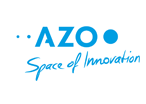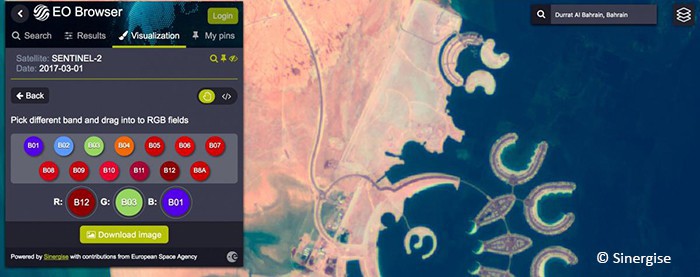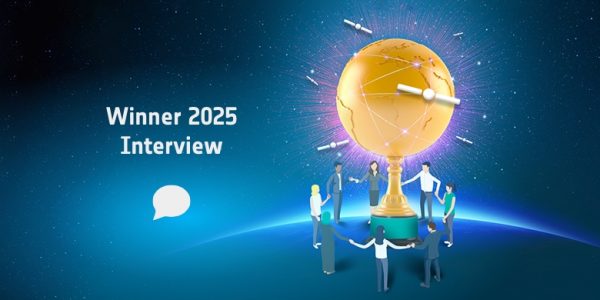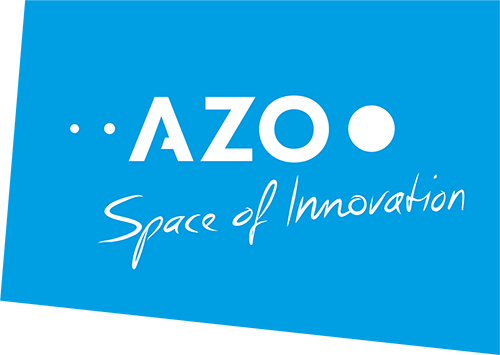The team around Grega Milcinski from Slovenia’s Sinergise Ltd. won the 2016 Copernicus Masters competition with Sentinel Hub – a pathbreaking cloud-based web service for satellite data.
Sinergise just recently announced that its free satellite imagery visualisation tool called EO Browser is online and ready to use. It offers the possibility to easily search and study vast amounts of archive and fresh satellite imagery residing in the cloud.
Learn more about the future-oriented company which aims at delivering large scale GIS applications. Discover the success story with all its challenges and visions in our interview with the CEO of Sinergise Grega Milcinski.
6 Questions to Sinergise
AZO: Please give us a sneak peek of your product and the team behind it.
Earth observation (EO) satellites, including the Sentinels of Europe’s Copernicus programme, produce tremendous amounts of data every day. This presents an enormous potential for scientific and commercial applications here on the ground. So far, however, downloading, processing, and storing petabytes of data has posed major challenges to many user groups. Sentinel Hub makes it possible to browse, process, and distribute large amounts of data quickly and efficiently – even for non-expert users. Thanks to its ability to integrate into any GIS or web application, this online service is poised to fundamentally affect the daily work routines of developers, scientists, and many other target groups.
With creating Sentinel Hub, our vision was to create tools for beginners and experts which allow users to explore the ground and, if desired to perform advanced analytics on top of it. Applicants can use these tools just for fun or benefit from the data integration in their GIS application within a few seconds.
AZO: What was your company’s biggest challenge so far?
Our main challenge was to figure out how to get fast and efficient access to the data. We got in contact with Amazon and agreed to establish a freely accessible replica of the Sentinel archive on its Web Services (AWS). They provided us some free credits to create a user-friendly service tool to view, download and process Sentinel-2 data. This service is now available for companies which can use it to fast-forward their development and adapt their services and products to specific end users’ needs. The other encountered problems were much smaller. However, there were hundreds of them for which we had to find a working solution.
AZO: Can you explain the three main ingredients of your recipe for success?
The team, the team again and enthusiasm. I specifically named the team twice as I can’t stress the importance of it enough. That is everything a successful business needs. And perhaps a bit of luck, but this is far behind. Sentinel Hub was founded without having a single remote sensing expert on board. This lack of an Earth Observation expert led us to create a completely new and user-friendly tool, as standard tools like Sentinel Application Platform (SNAP) or Geospatial Data Abstraction Library (GDAL) could not entirely satisfy our needs. Before using satellite imagery, users first had to pre-process the data – which is impossible without having a dedicated Earth Observation expertise. We found a way to deal successfully with this problem. For us, who have a completely different background, it is very encouraging to explain our solution to Earth Observation experts and share their moment of realisation that pre-processing now belongs to the past. This moment rewards all our efforts and proves the sustainability and success of our work.
AZO: What do you expect from the Copernicus Masters? How did the competition and its network help you to kick-start your business case?
When we submitted our idea to Copernicus Masters in 2016, we already had a working solution, but very few users. The idea seemed so far-fetched that people did not believe in it, they were not even willing to try. Becoming the Overall Winner of the competition and benefitting from the follow-up coaching service provided by Francesco Liucci from Catapult, within the Copernicus Accelerator framework, helped us to boost our idea even further and to gain confidence from experts worldwide. Put into figures, our newly released EO Browser has the huge number of 1.1 million processed requests by nearly 12,000 users. That is unbelievably wonderful!
AZO: Let’s reach for the stars – what is going to happen in your company’s future?
Our main goal is to become the main Earth Observation data source for application developers around the world. There are several dedicated people from Europe, Africa, Australia and South America, who are already working with our tool. Currently, we serve about two million requests per week and our dream is that this number grows a hundredfold. Earth Observation data are extremely valuable nowadays and Copernicus, together with Landsat, set the ground for the emergence of new markets by providing data free of charge. With Sentinel Hub they are not just for free, they are also easy to access. Together with GeoVille – a service consultancy for geo-information applications specialising in satellite Earth observation -, we have recently won an H2020 grant to make it even easier for developers to build added value services. This means that everything is set for the Earth observation revolution to begin!
AZO: Anything else you want to share with us?
On our way to becoming a recognised player in this field we have received an enormous support by ESA, especially its Earth observation group. They have recognised our potential and helped us in several ways, most importantly providing technical guidance and relevant contacts. They helped us to find relevant partners. We were glad to express our gratitude to ESA Director General Mr. Wörner, who visited our headquarters in February 2017. Thank you very much, ESA!
To the readers – go and explore Sentinel data yourselves as well. It is like exploring the world – you might find images that no one has ever seen before. Today, you would need almost 100 million computer screens to show the complete outreach of the existing data. Once Sentinel-2B joins the pack, there will be about half a million of new screens added every day. After having checked the visual spectrum, we recommend to dive into other spectrum bands. To get a full image of the Earth, 150 million people have to check at least one image every day. There is still so much to discover!
Do you want to write your own chapter of the Copernicus Masters success story? Then go ahead and pre-register now for the 2017 edition to turn your idea into business, just like Sinergise did.
About the Copernicus Masters and the Copernicus Accelerator
AZO has launched the Copernicus Masters in 2011 on behalf of the European Space Agency (ESA) and with strong support of world-class partners as part of their mission to foster the User Uptake of Copernicus services. The Copernicus Masters is an international competition which awards prizes to innovative solutions for business and society based on Earth observation data. The Copernicus Masters has developed into the moving force of promoting cutting-edge solutions. In 2016, the European Commission has launched Copernicus Accelerator. This one-of-a-kind programme is focused on providing a tailored business coaching service for up to 40 finalists in the Copernicus Masters competition. The submission phase for the Copernicus Masters 2017 starts on 1 April.




